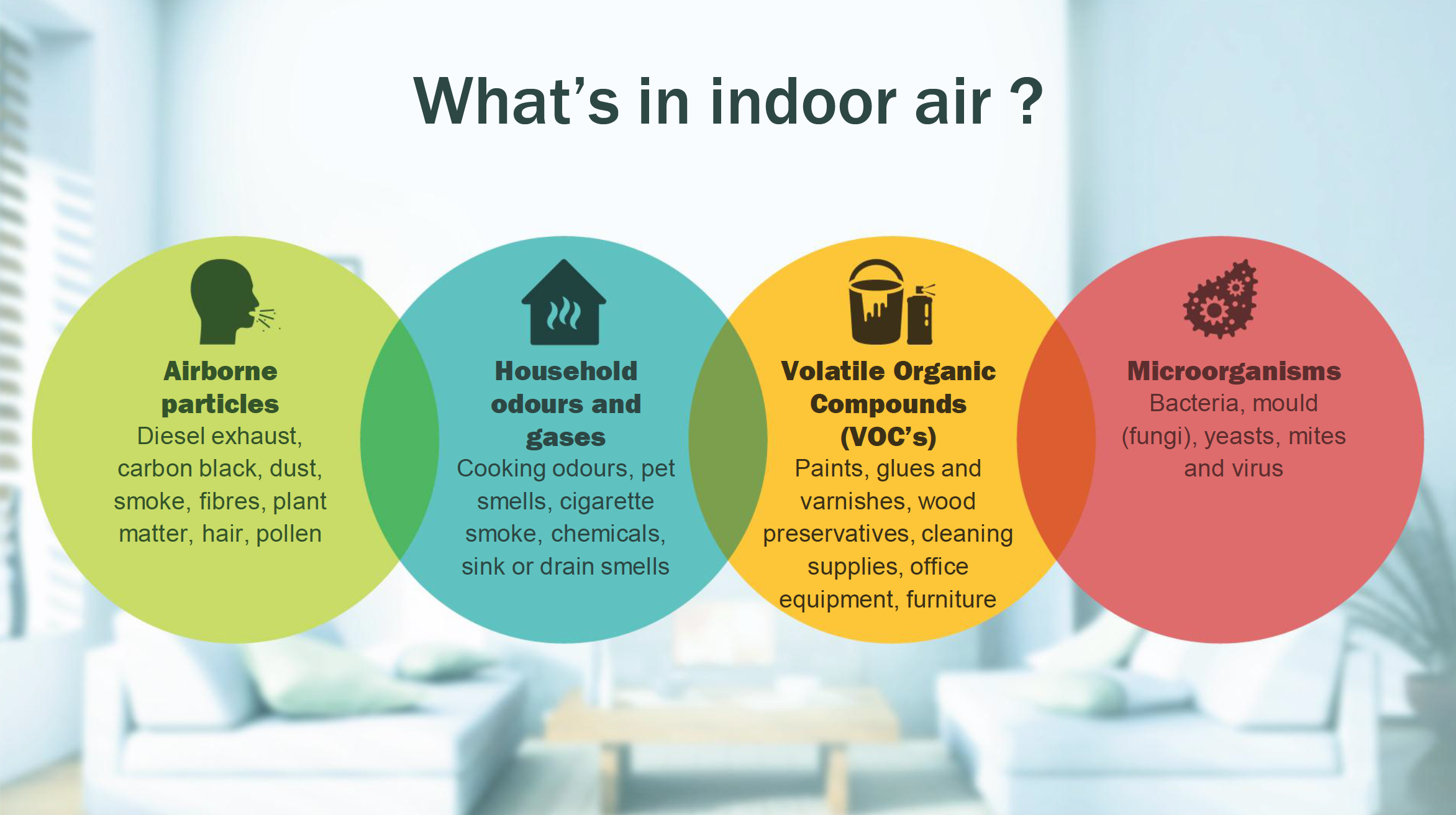Indoor air quality is a critical aspect of our overall health that often goes unnoticed. With people spending an astounding 90% of their lives indoors, the air we breathe within our homes, offices, and schools can significantly impact our well-being. Poor indoor air quality can lead to various health effects, including respiratory issues, fatigue, and diminished cognitive function. The presence of indoor air pollution, such as volatile organic compounds and allergens, can exacerbate these problems. Therefore, understanding how to improve indoor air quality in our environments is essential for cultivating healthy buildings and promoting indoor environmental health.
When we discuss the significance of indoor atmosphere, alternative terms like indoor environmental conditions or air quality in enclosed spaces come to the forefront. The influence of these conditions on our health and productivity cannot be overstated; they are integral to creating spaces that enhance wellbeing. As we navigate our daily lives within these indoor realms, focusing on achieving optimal air quality becomes a priority for both individuals and communities. Implementing strategies to reduce indoor air contaminants and promote fresher air can lead to healthier living spaces. Thus, understanding and addressing the factors contributing to indoor air quality is essential for fostering a safe and healthy environment.
Understanding Indoor Air Quality and Its Importance
Indoor air quality (IAQ) refers to the air quality within and around buildings, particularly as it relates to the health and comfort of building occupants. Many individuals spend the majority of their lives indoors, leading to a significant impact on their occupancy experiences and health. Poor indoor air quality can contribute to a range of health issues, from respiratory ailments to cognitive decline. Understanding the components that compromise IAQ is essential for creating healthier living and working environments.
Several factors contribute to indoor air pollution, including volatile organic compounds (VOCs) released from common household products, inadequate ventilation systems, and the accumulation of dust and allergens. Inadequate ventilation allows pollutants to remain in indoor spaces, which can exacerbate symptoms for those with asthma or allergies. Effective management of indoor air quality can lead to significantly improved health outcomes and increased overall productivity.
Health Effects of Indoor Air Pollution
Indoor air pollution is a major concern for public health, as pollutants can severely affect both physical and mental well-being. Health effects stemming from poor indoor air quality can range from minor irritations, such as headaches and fatigue, to more severe conditions like chronic respiratory diseases and heart disease. Research suggests that environments with insufficient ventilation and high levels of indoor pollutants can negatively impact workers’ cognitive functions, thereby reducing their overall productivity.
Also, vulnerable populations such as children and the elderly are at a higher risk of the adverse effects of indoor air pollution. With children spending significant time in schools and homes, ensuring clean, healthy air in these spaces is paramount. Increasing awareness of the health effects of indoor air quality can promote actions that lead to immediate improvements, such as adopting better HVAC systems or introducing plants that purify the air.
Strategies to Improve Indoor Air Quality
Improving indoor air quality is essential for fostering healthier living and workspace environments. Simple changes can make a considerable difference. Increasing ventilation by opening windows and upgrading HVAC systems to enhance air filtration can drastically reduce pollutant levels. Invest in HEPA filters which can trap a higher percentage of airborne particles, creating a cleaner and healthier indoor atmosphere.
Regular maintenance of humidity levels can also aid in improving indoor air quality, as excessive moisture can lead to mold growth and respiratory issues. Additionally, incorporating indoor plants can serve as a natural way to purify air by absorbing toxins while contributing to a healthier environment overall. Implementing these strategies can result in long-term benefits for occupants’ health and well-being.
Creating Healthy Buildings: A New Paradigm
The concept of healthy buildings emphasizes the importance of designing and maintaining spaces that foster physical health and well-being. This approach focuses on the impact of indoor environmental health on occupants and advocates for improvements in air quality, lighting, and acoustics. By prioritizing the health of building occupants, organizations can expect to see enhanced productivity levels and reduced sick days among employees.
Moreover, creating healthy buildings goes beyond mere aesthetics; incorporating biophilic design and natural materials can aid in better overall air quality and occupant comfort. These architectural considerations not only result in more pleasant environments but also support mental health, further encouraging a holistic approach to indoor environmental health.
The Role of Ventilation in Indoor Air Quality
Ventilation plays a critical role in maintaining indoor air quality by reducing indoor air pollution levels. It facilitates the exchange of indoor air with outdoor air, thus diluting any contaminants that may accumulate within. In many older buildings, however, ventilation systems are inadequate, leading to increased health risks for occupants. This highlights the importance of upgrading ventilation systems to ensure they meet modern standards.
The type of ventilation system implemented can greatly affect indoor air quality outcomes. For instance, natural ventilation can be effective in mild climates, while mechanical ventilation systems can be better suited for densely populated areas and buildings that lack sufficient airflow. A well-designed ventilation strategy not only improves air quality but also enhances comfort levels, making it a fundamental aspect of building health.
The Connection Between Indoor Air Quality and Productivity
Indoor air quality has a significant impact on productivity in the workplace. Studies have shown that poor air quality can lead to decreased cognitive functions, fatigue, and an increase in sick leave. By improving factors such as air exchange rates and reducing pollutants, companies can foster an environment where employees can thrive, ultimately leading to enhanced performance and morale.
Moreover, workplaces that prioritize good indoor air quality often observe lower rates of absenteeism and higher employee retention. Employers can benefit from investing in regular air quality assessments and enhancements to their existing systems. Creating an environment that prioritizes health can consequently lead to happier, healthier, and more productive teams.
Choosing Indoor Plants for Improved Air Quality
When selecting indoor plants, choosing species that are known for their air-purifying qualities can significantly enhance indoor air quality. Plants such as spider plants, peace lilies, and snake plants are recognized for their ability to absorb common indoor pollutants like formaldehyde and benzene. Incorporating these plants into living and working spaces not only improves air quality but also positively impacts mental health by bringing natural elements indoors.
Additionally, caring for plants can offer psychological benefits through stress reduction and increased feelings of well-being. As such, organizations and homeowners alike are encouraged to consider integrating greenery into their environments to reap the dual rewards of cleaner air and enhanced emotional health.
The Importance of Regular Air Quality Testing
Regular air quality testing is paramount in monitoring and ensuring that indoor environments remain healthy and safe. By conducting routine assessments, building managers and homeowners can identify potential pollutants and take proactive steps to address them before they escalate into serious health risks. Testing also helps track improvements made after implementing air quality enhancements, thus verifying the effectiveness of any changes.
Moreover, air quality tests can provide invaluable data on particulate matter, VOC levels, and humidity, all of which contribute to overall indoor environmental health. Being informed allows individuals and organizations to make educated decisions about their air quality management strategies, leading to healthier living and working spaces.
Mitigating Indoor Air Pollution from Common Sources
Identifying and mitigating indoor air pollution sources is crucial for maintaining good indoor air quality. Common sources of pollutants include tobacco smoke, mold, pet dander, and combustion appliances like stoves and heaters. Addressing these issues involves not only eliminating the sources but also improving ventilation and filtration systems to minimize pollutant accumulation.
In addition to physical measures, raising awareness about practices that enable cleaner indoor air is important. Encouraging behaviors such as removing shoes indoors, using non-toxic cleaning products, and implementing regular cleaning schedules can greatly reduce the presence of indoor air pollutants. Every individual plays a role in creating a healthier indoor environment.
Frequently Asked Questions
What are the health effects of indoor air quality?
Indoor air quality significantly impacts health, leading to respiratory issues, allergies, headaches, and fatigue. Poor indoor air can also exacerbate conditions like asthma and other chronic illnesses, highlighting the importance of maintaining healthy buildings with good air quality.
How does indoor air pollution affect my daily life?
Indoor air pollution can reduce concentration and cognitive function, making it harder to work effectively or study. Common pollutants include volatile organic compounds (VOCs), mold, dust, and allergens, which can affect overall well-being and productivity.
What steps can I take to improve indoor air quality?
To improve indoor air quality, ensure proper ventilation, use air purifiers with HEPA filters, minimize chemical exposure from cleaning agents, and regularly maintain HVAC systems. Also, controlling humidity levels and using houseplants can enhance the indoor environment.
Why are healthy buildings important for indoor environmental health?
Healthy buildings promote indoor environmental health by reducing exposure to harmful pollutants and improving air quality. Features like increased natural light, effective ventilation, and non-toxic materials contribute to better physical and mental health outcomes.
How much of outdoor air pollution do we inhale indoors?
Surprisingly, we inhale a significant amount of outdoor air pollution indoors, as pollutants can drift in through windows, doors, and ventilation systems. Maintaining good indoor air quality is essential to minimize these risks and enhance personal health.
What role does ventilation play in indoor air quality?
Ventilation is crucial for enhancing indoor air quality by diluting indoor pollutants and bringing in fresh outdoor air. Increasing air changes per hour can help reduce airborne contaminants, improve health, and enhance cognitive ability.
Can indoor air quality affect my immune system?
Yes, poor indoor air quality can weaken the immune system, making individuals more susceptible to infections and illnesses. Addressing pollutants and ensuring good ventilation are essential for a healthy indoor environment.
What common sources contribute to indoor air pollution?
Common sources of indoor air pollution include household cleaning products, paint, mold, dust mites, smoke, and inadequate ventilation. Recognizing and addressing these sources is vital for maintaining good indoor air quality.
Are there specific indoor air quality guidelines to follow?
Yes, various organizations like the Environmental Protection Agency (EPA) provide guidelines for indoor air quality, including recommendations for ventilation rates, permissible pollutant levels, and best practices for maintaining a healthy indoor environment.
How can I test the indoor air quality of my home?
You can test indoor air quality using DIY air quality test kits available in stores or online. These kits can measure levels of common pollutants such as formaldehyde, VOCs, allergens, and particulate matter, helping you identify issues and improve air quality.
| Question | Options | Fact |
|---|---|---|
| 1. How much of their lives do Americans on average spend indoors? | a) 80% b) 65% c) 90% d) 75% |
Americans spend about 90% of their lives indoors. |
Summary
Indoor Air Quality plays a crucial role in our health, as we spend a significant portion of our lives indoors. From workplaces to homes and schools, the quality of the air we breathe can greatly impact our overall well-being, cognitive functions, and susceptibility to illnesses. The statistics and studies highlighted reveal the importance of improving indoor environments by enhancing ventilation and air quality standards to ensure we can thrive in our daily spaces.



